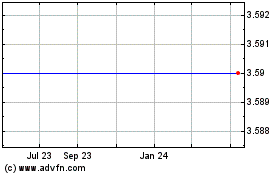Digirad Corporation Developing New Cardiac Imaging System With Distortion Correction
September 05 2008 - 6:00AM
PR Newswire (US)
Initial Clinical Trials Indicate Higher-Quality Scans in Shorter
Time With Negligible Radiation Dose POWAY, Calif., Sept. 5
/PRNewswire-FirstCall/ -- Digirad Corporation (NASDAQ:DRAD), a
leading provider of medical diagnostic imaging systems and services
to physicians' offices, hospitals and imaging centers, today
announced the initial clinical trial of a new imaging system
incorporating new proprietary technology to correct attenuation, or
image distortion, an inherent issue in cardiac SPECT imaging.
Cardiac SPECT (single photon emission computed tomography) -- also
called myocardial perfusion imaging -- is a non-invasive test to
assess the heart's structure and function. Small amounts of
radioactive substances are injected into the patient's vein, and
special cameras produce images of the heart. These SPECT images are
used to identify blockages in coronary arteries, determine whether
a patient has had a heart attack, evaluate risk of a heart attack,
and assess a patient's condition after bypass surgery or
angioplasty. According to Senior Vice President of Technology
Richard Conwell, attenuation is the most significant issue in
cardiac SPECT. There are alternative solutions that attempt to
address this problem, but they involve tradeoffs, such as "noisy"
images, truncated scans, lengthy procedures with risk of excess
movement by patients, or higher levels of radiation dosage. Chief
Executive Officer Mark Casner commented: "Research and development
was based on our Cardius 3 triple-head SPECT camera, and feedback
from initial clinical trials at the University of California, Los
Angeles (UCLA) is promising, compared to other SPECT systems at
competitive price points. We are seeing improvement in imaging
clarity and accuracy, more rapid imaging, and a significant
reduction in radiation dosage. In addition, we may be able to
eliminate the need for isotope replacement resulting in lower
operational costs." Casner said that the new system, Cardius
X-ACT(TM), will be exhibited at the 2008 Annual Scientific Session
of the American Society of Nuclear Cardiology (ASNC) to be held on
September 10-14, 2008, at the John B. Hynes Convention Center in
Boston. In coordination with ASNC events, Digirad will host a
luncheon symposium on September 13, from noon to 1:30 p.m., that
will be moderated by Jamshid Maddahi M.D., F.A.C.C. and will
include recent advances in solid-state detectors, rapid SPECT
imaging, x-ray attenuation correction (VCT), and multi-center trial
results of rapid imaging. In addition to the initial study at UCLA,
Casner said that two other clinical studies are planned. The new
Cardius X-ACT system is expected to be available for sale sometime
in mid-2009 pending required regulatory approvals. About Digirad
Digirad Corporation provides diagnostic nuclear and ultrasound
imaging systems and services to physicians' offices, hospitals and
other medical services providers for cardiac, vascular, and general
imaging applications. Digirad's Cardius XPO line of nuclear imaging
cameras use patented solid-state technology and unique multi (dual,
triple) head design for superior performance and advanced features
for sharper digital images, faster processing, compact size,
lighter weight for portability, ability to handle patients up to
500 pounds, and improved patient comfort compared to standard
nuclear cameras. Digirad's 2020tc general-purpose nuclear imager
has a small footprint and may also be configured for fixed or
mobile use to supplement primary imaging. Digirad's installed base
of equipment exceeds 550 systems; in addition, a mobile fleet of
164 nuclear and ultrasound imaging systems is being used in 22
states and the District of Columbia, primarily in the eastern,
midwestern and southwestern United States. For more information,
please visit http://www.digirad.com/. Digirad(R), Digirad Imaging
Solutions(R), and Cardius(R) are registered trademarks of Digirad
Corporation. Forward-Looking Statements Statements in this press
release that are not a description of historical facts are forward
looking statements. You can identify these statements by the fact
that they do not relate strictly to historical or current facts and
use words such as "anticipate," "estimate," "expect," "project,"
"intend," "plan," "believe" and other words and terms of similar
meaning. Examples of such forward looking statements include
statements regarding continuing research and development,
competitive factors, expected improvements in performance, timeline
for entering and completing clinical trials, and timeline for
new-product availability. Actual performance and benefits results
may differ materially from those set forth in this press release
due to risks and uncertainties inherent in Digirad's business
including, without limitation, changes in business conditions,
technology, customers' business conditions, work force, suppliers,
business prospects, economic outlook, operational policy or
structure, acceptance and use of Digirad's camera systems and
services, reliability, recalls, and other risks detailed in
Digirad's filings with the U.S. Securities and Exchange Commission,
including Annual Report on Form 10-K, Quarterly Reports on Form
10-Q, Form 8-K and other reports. Readers are cautioned to not
place undue reliance on these forward looking statements, which
speak only as of the date hereof. All forward looking statements
are qualified in their entirety by this cautionary statement, and
Digirad undertakes no obligation to revise or update the forward
looking statements contained herein. Investor Contact: Company
Contact: Dan Matsui Todd Clyde, CFO Allen & Caron 858-726-1600
949-474-4300 DATASOURCE: Digirad Corporation CONTACT: Investors,
Dan Matsui of Allen & Caron, +1-949-474-4300, for Digirad
Corporation; or Todd Clyde, CFO of Digirad Corporation,
+1-858-726-1600, Web site: http://www.digirad.com/
Copyright
Digirad (NASDAQ:DRAD)
Historical Stock Chart
From May 2024 to Jun 2024

Digirad (NASDAQ:DRAD)
Historical Stock Chart
From Jun 2023 to Jun 2024
